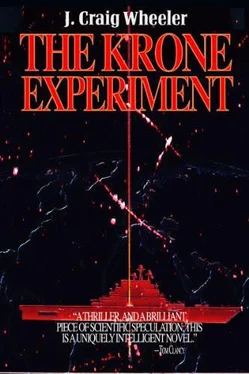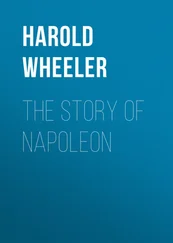“Run this stolen property back to the galley for me, won’t you?” he asked the young man and then jogged to the hatch of the helicopter as the rotors began to pick up speed.
The last one in, Runyan sat near the small port. They lifted quickly and the Bradford rapidly disappeared beneath them, but as it did Runyan could see the faint lights of other ships come into view, scattered sparsely over the ocean as far as he could see in any direction. He did not bother to count them; he knew it was pointless since there were over a thousand, ranging from small craft like the Bradford to a handful of hulking carriers. He settled in for the familiar, minimally comfortable half-hour ride.
They did not approach it on a direct line, probably because of other air traffic, Runyan mused, and he could begin to make it out when it was still some ten miles away—a floating behemoth extravagantly lit, a sparkling diamond, a cross section of L.A. from Mulholland Drive. They hovered nearby while another helicopter landed and took on a load of people.
Runyan marveled again at the structure below. It was patterned after an oil drilling rig, but was specially constructed in almost every detail. It spanned a hundred meters on a side and was covered with a complex superstructure dominated by the central dome, two and a half billion dollars of floating technology. The helicopter spun and settled toward the pad, a white circle surrounding a stark black letter K, the only hint of the prime contractor: Krone Industries.
Runyan jumped out and walked off the pad, thankful for the firmness beneath his feet. The platform was anchored by a dozen telescoping floodable legs that extended deep down to the stable layers beneath the ocean swells that rocked the Bradford. It felt as solid as St. Paul. Here was a place where a man could put on his pants in civilized fashion, thought Runyan, rubbing the bruise on his forehead. Behind him the helicopter filled with departing personnel and lifted off.
Korolev assembled the small group of men.
“Okay,” he said, “you know your tasks. You are to oversee the last minute checks and then, most importantly, make sure every member of your crew gets off the platform. You all know your scheduled departure times?” He looked around the group, satisfied at their affirmative nods. “Okay, I will see you back on the Bradford.”
Runyan knew that he should go immediately to the computer room, but he was confident that his people would have everything under control, and he wanted a last look. As he made his way through the corridors, he noticed how empty they felt. The platform had bustled with a thousand souls for a year, but now was down to a skeleton crew. He stepped into the central dome. The wave of deja vu was stronger than ever, amplified by the tension of this last morning. The device that loomed in the center of the room was more polished, but resounded with echoes of the machine Paul Krone had constructed that had brought them to this pass—a hedgehog array of gigantic lasers all focused into a central chamber where the hole would make its appearance in a little over two hours.
Unlike Krone’s original, this one was designed not to create and support, but to track and destroy. It was mounted on powerful hydraulic gimbals that allowed it to lift and settle, rotate and track. Each laser was individually aimed, controlled through an elaborate computer-driven feedback process. Although it weighed hundreds of tons and should have been ponderous, it was quick as a gunfighter. Runyan watched in awe as the device was put through its final paces, leaping and slurring with blurring speed. In principle it could follow the hole even though the platform were buffeted by gale force winds. This day was carefully chosen, however, the weather monitored for weeks, and all the device needed to do was follow a simple parabolic trajectory. Runyan shook his head as one would at the imminent death of a magnificent animal.
He left the dome and descended to the computer complex. He paused inside the door of the operations room and glanced through the window of the cubicle where the central computer stood. It was not much bigger than two men back-to-back, but was the state of the art parallel processing machine. In turn, it communicated with twenty-odd smaller dedicated machines scattered about the platform. Runyan made a silent tour of the room, pausing behind each of the half dozen operators at their terminals who made final cross checks before turning the whole operation over to the central computer. Signals from special seismic and sonar monitoring stations throughout the world were fed by satellite relay, so the computer could register the location of the hole instant by instant. Any perturbation in the orbit was translated into a signal to the powerful turbines in the bowels of the platform. These could drive the platform at a maximum speed of ten knots and represented the coarse guidance adjustment. Peering at one terminal, Runyan saw that the turbines were engaged to combat a small drift due to ocean currents. Another operator was checking the program that predicted the precise path of the hole as it rocketed up a reinforced shaft into the dome so the device there could anticipate how to move. Yet another tested the operation of the gravity detectors that would enable the lasers to focus their blast in the precise fashion to stimulate the hole to emit an even greater rocketing burst of energy. That release would reduce the mass of the hole and boost it, however minutely, further out of the Earth, closer to the sanctuary of space.
Everything looked in order, but Runyan felt a sickening knot in his stomach anyway. He and hundreds of others had worked very hard to determine the orbit of the hole. This site in the mid-Pacific had been selected with careful attention to the sub-mantle rock distribution to minimize any final perturbations to the hole’s orbit. He was too close to this aspect of the project, though, and knew that despite all their care, this was the weak link. A small last second nudge, a drift in the orbit, one that was a bit too large for the huge turbines and the snake-fast device overhead to accommodate, and the whole gigantic enterprise could backfire, sending the hole deeper into the Earth, beyond reach. Everything had seemed to function perfectly in half a dozen dry runs in which they had ambushed the hole, but allowed it to pass through their floating trap unmolested. This time they would pull the trigger. Their aim had to be true.
Runyan watched quietly for several minutes and then announced, “It’s 5 o’clock. Our ride leaves in ten minutes. Let’s button it up.”
The operators glanced at him and then finished their tasks, logging out, turning their functions over to the computer and the remote monitors. One by one they sighed, pushed back from their terminals and left the room. The last one leaned over and gave his terminal a perfunctory kiss and a pat. Runyan smiled, clapped him on the shoulder in sympathy, and followed him out.
They gathered by the pad and the helicopter dropped down out of the dark sky right on schedule. Runyan knew each of the men intimately, but went through the formality of checking each off on a list as they boarded the helicopter, attesting that they were safely off the platform. Then he climbed aboard himself and didn’t look back.
Back on the Bradford, Runyan stopped in the galley to choke down a doughnut and sip another cup of coffee. Then he joined the gathering crowd on the deck, their backs to the rosy dawn, their eyes on that which they couldn’t see, a hundred miles away across the flat ocean expanse. Runyan sought out Korolev. The Russian turned to face him, and they shook hands mutely, somberly, and then leaned on the rail staring like all the others.
After a while Korolev grumbled.
“I saw a report the other day.”
Читать дальше











